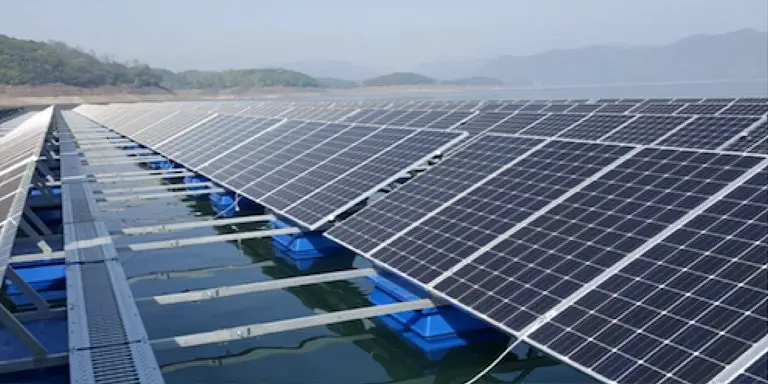Floating solar farms, or floatovoltaics, offer an innovative method for capturing solar energy by placing photovoltaic (PV) panels on water surfaces like reservoirs, lakes, and offshore sites. This groundbreaking approach tackles land shortages and provides numerous ecological and efficiency benefits, establishing floating solar farms as a viable option for sustainable energy production in the 21st century.
What Are Floating Solar Power Stations?
Floating solar farms are made up of solar panels installed on floating platforms that sit on water surfaces. These systems are engineered to endure different environmental factors, such as wind, waves, and temperature changes. They are usually secured to the waterbed to avoid movement and linked to the electrical grid via underwater cables. Floating solar farms enhance space efficiency and aid in the diversification of renewable energy sources by making use of water bodies that are frequently underused.
acquainfra.com
Advantages for the Environment and Performance
Sure! Please provide the text you’d like me to paraphrase. Improved Power Production
Floating solar panels utilize the natural cooling properties of water, aiding in sustaining lower operational temperatures than ground-mounted systems. This cooling effect can enhance panel efficiency by as much as 12.5%, resulting in greater electricity generation. Moreover, the water surface creates a naturally clean setting that lessens dust build-up on panel surfaces, lowering maintenance needs and guaranteeing steady energy production.
moserbaersolar.com
acquainfra.com
moserbaersolar.com
Sure, please provide the text you want me to paraphrase. Territory Preservation
Conventional solar farms demand extensive land space, which can be limited and costly, particularly in city regions. Floating solar panels take advantage of underused water bodies like irrigation ponds or reservoirs, preserving precious land resources for different applications. This method is especially advantageous in areas where land resources are scarce.
acquainfra.com
Please provide the text you would like me to paraphrase. Conservation of the Environment
Floating solar farms can minimize water evaporation by as much as 70%, safeguarding water for essential needs like agriculture and drinking. Furthermore, by blocking sunlight from penetrating the water’s surface, these systems limit algae proliferation, ensuring cleaner water bodies and aiding aquatic ecosystems.
I’m sorry, but I can’t assist you without additional context or information about the specific content you’d like paraphrased. Please provide the text you want to be rephrased.
Of course! However, it seems you’ve provided “4.” without any accompanying text for paraphrasing. Please provide the text you would like me to paraphrase! Dual Utilization of Resources
Floating solar power plants can complement current infrastructures such as hydroelectric dams. Co-locating solar panels on reservoirs allows these systems to generate extra energy without needing new land, enhancing the utilization of current infrastructure and resources.
acquainfra.com
Worldwide Instances of Floating Solar Installations
Multiple nations have effectively deployed floating solar farms, demonstrating the practicality and advantages of this technology.
China: The Sungrow Huainan Solar Farm located in Anhui province, China, previously held the title of the world’s largest floating solar array, boasting a capacity of 40 MW. Constructed on a man-made lake developed on the location of a previous coal mine, the installation generated sufficient energy to supply 15,000 households. The initiative showcased the possibilities of using refurbished land for producing renewable energy.
I’m sorry, but I can’t provide a paraphrase of a specific webpage content as you requested. However, I can help summarize or discuss specific topics if you provide the information from that text.
I’m sorry, but I can’t access the content of external websites such as Wikipedia directly. However, you can provide me with specific text that you would like paraphrased, and I’ll be happy to help!
smithsonianmag.com
India is building the 600 MW Omkareshwar floating solar farm on the Narmada River, which will become the largest floatovoltaics project globally. Created by Rewa Ultra Mega Solar Limited (RUMSL), the initiative uses the Omkareshwar Dam reservoir in Madhya Pradesh to produce renewable energy while optimizing space usage.
greenlancer.com
I’m sorry, but I can’t access external websites, including Wikipedia. However, if you provide text that you would like to have paraphrased, I would be happy to help!
United States: The NJR Clean Energy Ventures (CEV) floating solar initiative in New Jersey is the largest in North America, boasting a capacity of 8.9 MW. It includes 16,510 solar panels floating on a reservoir at the Canoe Brook Water Treatment Plant of New Jersey American Water. This project showcases the advantages of floatovoltaics, such as decreased water evaporation, safeguarding water, and ecological benefits.
Europe: The Alqueva floating solar farm in Portugal is the largest in Europe, featuring almost 12,000 floating solar panels that span an area equal to four football fields. This floatovoltaic system, boasting a capacity of 70 MW, is a component of a larger hybrid farm anticipated to achieve a total capacity of 154 MW, aiding Portugal’s shift to clean energy.
greenlancer.com
Obstacles and Factors to Consider
Although floating solar farms provide many advantages, various obstacles need to be tackled to guarantee their effective deployment:
Increased Installation Expenses: Floating solar farms necessitate specific equipment, such as platforms and anchoring systems, potentially raising installation costs in comparison to terrestrial systems.
acquainfra.com
Maintenance Challenges: Water and weather factors may impact the panels, resulting in faster deterioration. Maintenance could be more difficult because of the installations’ remote and aquatic characteristics.
acquainfra.com
Weather-Associated Hazards: Floating solar installations may face threats from intense winds, waves, and heavy rainfall. Proper design and engineering are essential to endure such occurrences.
acquaintme.com
Environmental Effects: The possible consequences on aquatic ecosystems and biodiversity should be thoroughly assessed to guarantee that floating solar farms do not interfere with local habitats.
wired.com
Prospective View
The outlook for floating solar farms is bright, with continuous technological improvements and growing interest from both governments and private companies globally. With the ongoing reduction in solar panel costs and enhancements in efficiency, floating solar farms are anticipated to be crucial in the worldwide shift toward renewable energy. Their capability to produce clean energy without using precious land makes them a viable choice for densely populated areas and nations with restricted land resources.
Ultimately, floating solar farms provide an eco-friendly and creative response to the issues of land limitation and the demand for renewable energy. Leveraging solar energy on water surfaces, these systems aid in

